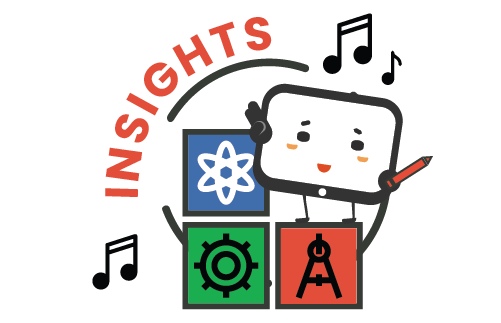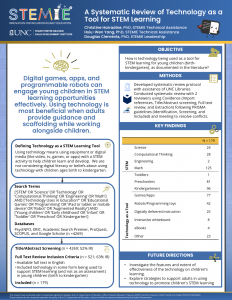Using Technology as a STEM Learning Tool for Young Children Technology as a STEM Learning Tool
Posted on June 19, 2025 in

Digital games, apps, programmable robots, and other types of technology can engage young children in STEM learning opportunities effectively. Using technology is most beneficial when adults provide guidance and scaffolding while working alongside children.
Using technology as a STEM learning tool means using equipment (like tablets, computers, robots, and interactive whiteboards) or digital media (like video, digital curriculum, games, and apps) with an activity to help children learn and develop STEM learning. Let’s explore how different types of technology can be effectively integrated into early childhood education to enhance STEM learning. 
Robots and Programming Toys
Robots and coding toys are excellent tools for teaching children coding concepts, science principles, foundational math skills, engineering, and problem-solving. These tools are most effective when used in an interactive and engaging manner, with adults actively providing scaffolding through open-ended questions. This approach encourages children to explore and experiment, fostering a deeper understanding of the concepts being taught.
Interactive Whiteboards
Interactive whiteboards (IWBs) are large, touch-sensitive screens that allow multiple users to manipulate digital content in real-time. Also known as smartboards, electronic whiteboards, or digital whiteboards, IWBs help children acquire operational skills in math and science more effectively than traditional teaching methods. They improve understanding by providing cumulative feedback and built-in support. IWBs enable children to categorize visual images, demonstrating their ability to understand similarities and differences between ideas and relate what they have learned to everyday experiences. Studies showed the combination of increased visual and auditory stimuli, along with the opportunity for physical interaction with the IWB, enhanced young children’s focus and engagement.
Digital Games and Apps
Digital games and apps designed with learning principles can provide foundational skills to children, including those from under-resourced backgrounds and preschool children with disabilities1. When games involve multisensory and direct interactions, adapt to the child’s ability level, and set further levels accordingly, they prevent frustration and sustain the child’s interest long enough for learning to occur. In one study, the use of apps combined with hands-on manipulatives was more effective than traditional classroom math instruction. Games and apps that use playful, immediate, and continuous feedback show promise for young children’s STEM learning. Check out STEMIE’s “My STEM Adventure” app, an interactive, accessible app that allows young children to create their own digital stories based on their STEM explorations.
Digital Curriculum
Digital curriculum refers to educational content presented in digital form, which can include core curriculum, supplemental resources, or both. It encompasses various formats such as text, images, video, audio, and interactive modules. Research has shown that evidence-informed computer-assisted instruction can significantly enhance mathematics knowledge and coding performance in preschoolers, including those with disabilities.
Other
Digital cameras, eBooks, augmented reality, videos and animations, television, and interactive toys—such as blocks that make animal noises—have all been shown to positively impact young children’s STEM learning. These tools also support the development of abstract concepts, especially when parents and teachers guide and engage with the children as they use these technological resources.
Conclusion
Integrating technology into early childhood education offers numerous benefits for STEM learning. Digital games, apps, robots, programming toys, digital curriculum, interactive whiteboards, and other technological tools can significantly enhance children’s understanding of STEM concepts. These tools are most effective when used interactively and with adult guidance, providing children with engaging and meaningful learning experiences. By leveraging these technologies, we can foster a love for STEM in young learners and equip them with essential skills for their future education.
Resources:
A Systematic Review of Technology as a Tool for STEM Learning

Technical assistance specialist at the UNC Frank Porter Graham Child Development Institute
Harradine, C., Yang, H.W., & Clements, D.H. (2025). A Systematic Review of Technology as a Tool for STEM Learning [PDF]. The University of North Carolina at Chapel Hill, Frank Porter Graham Child Development Institute, STEM Innovation for Inclusion in Early Education (STEMIE). https://stemie.fpg.unc.edu/resource/a-systematic-review-of-technology-as-a-tool-for-stem-learning/
Bower, C. A., Zimmermann, L., Verdine, B. N., Pritulsky, C., Golinkoff, R. M., & Hirsh-Pasek, K. (2022). Enhancing spatial skills of preschoolers from under-resourced backgrounds: A comparison of digital app vs concrete materials. Developmental Science, 25(1).
Chmiliar, L. (2017). Improving learning outcomes: The iPad and preschool children with disabilities. Frontiers in Psychology, 8, 1-11.
Praet, M., & Desoete, A. (2014). Enhancing young children’s arithmetic skills through non-intensive, computerised kindergarten interventions: A randomised controlled study. Teaching and Teacher Education, 39, 56-65.
Bers, M. U., González-González, C., & Armas-Torres, M. B. (2019). Coding as a playground: Promoting positive learning experiences in childhood classrooms. Computers & Education, 138, 130-145.
Chung-Oi, K. (2023). Learning science through the Artec Robotics Program for preschools in Singapore. Journal of Educational Research, 116(2), 113-123.
Peretti, G., Villani, D., Marangi, M., Pellizzari, F., Di Bruno, S., Guida, I., Marchetti, A., Riva, G., Rivoltella, P. C., & Massaro, D. (2020). Coding with me: Exploring the effect of coding intervention on preschoolers’ cognitive skills. Annual Review of CyberTherapy and Telemedicine, 18, 153-156.
Thai, K.-P., Bang, H. J., & Li, L. (2022). Accelerating early math learning with research-based personalized learning games: A cluster randomized controlled trial. Journal of Research on Educational Effectiveness, 15(1), 28-51.
Tazouti, Y., Thomas, A., Hoareau, L., Jarlégan, A., Hubert, B., & Luxembourger, C. (2023). Assessment of an educational classroom app’s impact on preschoolers’ early numeracy skills. European Journal of Psychology of Education.
Swaminathan, S., Mazza, J., & Lisenbee, P. S. (2021). Impact of coding on preschoolers’ math abilities. Paper presented at the Annual Meeting of the American Educational Research Association in April 2021.
Yang, W., Ng, D. T. K., & Su, J. (2023). The impact of story-inspired programming on preschool children’s computational thinking: A multi-group experiment. Thinking Skills & Creativity, 47.
Yong Joon, P. (2013). The relative effectiveness of teacher-made games for preschoolers’ understanding number concepts. Asia-Pacific Journal of Research in Early Childhood Education, 7(1), 93-119.
Schacter, J., & Jo, B. (2016). Improving low-income preschoolers mathematics achievement with Math Shelf, a preschool tablet computer curriculum. Computers in Human Behavior, 55, 223-229.
Yang, Z., Shaffer, P. M., Hagan, C., Dubash, P., & Bers, M. (2023). Impact study of the coding as another language curriculum. Grantee Submission.
Hitchcock, C. H., & Noonan, M. J. (2000). Computer-assisted instruction of early academic skills. Topics in Early Childhood Special Education, 20(3), 145-158.
Soydan, S. (2015). Analyzing efficiency of two different methods involving acquisition of operational skills by preschool children. EURASIA Journal of Mathematics, Science & Technology Education, 11(1), 129-138.
Preston, C., & Mowbray, L. (2008). Use of ‘SMART’ boards for teaching, learning and assessment in kindergarten science. Teaching Science, 54(2), 50-53.
Salminen, J. B., Koponen, T. K., Leskinen, M., Poikkeus, A.-M., & Aro, M. T. (2015). Individual variance in responsiveness to early computerized mathematics intervention. Learning & Individual Differences, 43, 124-131.
Bakar, K. A., Yunus, F., Mohamed, S., & Karim, A. A. (2020). Addition concept through the lenses of young children: Creating visual representation with digital cameras. EURASIA Journal of Mathematics, Science and Technology Education, 16(6).
Bonus, J. A., & Mares, M.-L. (2018). When the sun sings science, are children left in the dark? Representations of science in children’s television and their effects on children’s learning. Human Communication Research, 44(4), 449-472.
Shamir, A., & Lifshitz, I. (2013). E-books for supporting the emergent literacy and emergent math of children at risk for learning disabilities: Can metacognitive guidance make a difference? European Journal of Special Needs Education, 28(1), 33-48.
Silander, M., Moorthy, S., Dominguez, X., Hupert, N., Pasnik, S., & Llorente, C. (2016). Using digital media at home to promote young children’s mathematics learning: Results of a randomized controlled trial. Society for Research on Educational Effectiveness.
Kewalramani, S., Palaiologou, I., & Dardanou, M. (2020). Children’s engineering design thinking processes: The magic of the robots and the power of blocks (electronics). EURASIA Journal of Mathematics, Science and Technology Education, 16(3).
Angeli, C., & Valanides, N. (2020). Developing young children’s computational thinking with educational robotics: An interaction effect between gender and scaffolding strategy. Computers in Human Behavior, 105.
Kermani, H. (2017). Computer mathematics games and conditions for enhancing young children’s learning of number sense. Malaysian Journal of Learning and Instruction, 14(2), 23-57.


